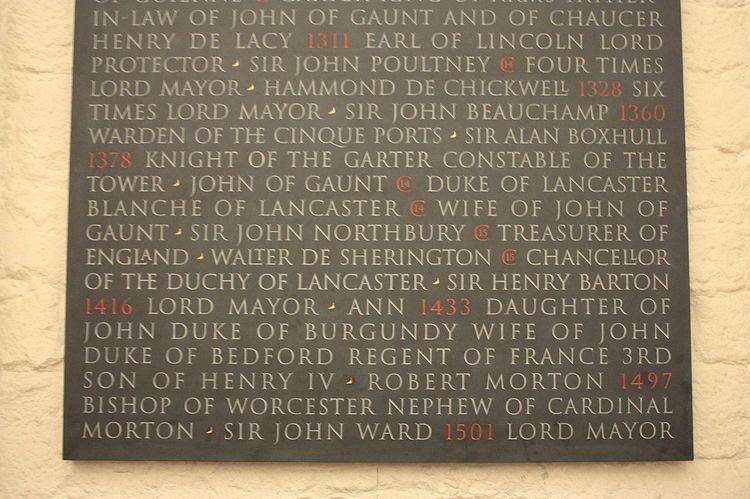Spouse(s) Margaret de Bereford Died June 8, 1349 Name Sir de | Mother Matilda Father Adam de Pulteney | |
 | ||
Sir John de Pulteney or Sir John Poultney (died 8 June 1349) was a major English entrepreneur and property owner, who served four times as Mayor of London.
Contents
Background
A biography of Sir John, written by Charles Lethbridge Kingsford, that was published in the Dictionary of National Biography, 1885-1900, Volume 47 contains much well-referenced information. However, it is inaccurate in stating the Sir John’s wife was a daughter of John de St John of Lageham, for reasons that are set out in detail in two articles by Walter Lee Sheppard Jr.
His will identifies Sir John's parents as Adam and Matilda.
Marriage and family
Sir John married Margaret, daughter of John de Bereford, citizen of London and his wife Roesia. The marriage evidently took place by 13 December 1330, when they arranged for perpetual masses for themselves and “for the souls of John de Bureford late citizen of London and Roesia his wife” to take place at St Nicholas Shambles, London. His association with the de Bereford family went back significantly before 1330, as in July 1318 he was recorded as executor of the will of Roesia de Bureford, late the executrix of John de Bureford, citizen of London.
The couple had one known child:
Shortly after Sir John’s death, his widow married Sir Nicholas de Loveyne
As with most Lord Mayors, he was buried in Old St Paul's Cathedral, but consequently the grave and monument were destroyed along with the cathedral in the Great Fire of London in 1666. A modern monument in the crypt lists him among the important graves lost.
Career
Sir John was a citizen of London and a member of the Drapers’ Company.
His business activities included the lending of money. For instance, in July 1325, Robert Burdet of Sheepy, Leicestershire acknowledged that he owed £100 to John de Pulteney. In the following month, the Prior of the Hospital of St John of Jerusalem in England acknowledged that he owed John the sum of £800. John also lent money to the King, such as an unstated sum that in June 1329 was outstanding but secured on the customs revenue of Southampton.
He served as Mayor of London in 1331, 1332, 1334 and 1336 and also held the office of Escheator of the City of London. Other roles that he undertook included membership of commissions of oyer and terminer in a number of counties, guardian of the peace for Middlesex and roles in negotiations with Flanders.
Building Projects
Sir John invested some of his considerable wealth in notable building projects, including those listed below. He appears to have been particularly active on these matters around 1341; on 6 October of that year, he was granted a licence to crenelate the dwelling places of his manors at Cheveley, Cambridgeshire and Penshurst Kent, as well as his dwelling place in London.
Death and Property
Sir John died on 8 June 1349, a date that suggests he may have been a victim of the Black Death, although no documentary evidence appears to support that possibility.
At the end of his life, he owned or had interests in the following properties that were identified at the subsequent inquisitions post mortem:
Will
His will was made on 14 November 1348 and proved at the Court of Hustings, London.It contained bequests to support chantries in St Paul’s Cathedral and prayers for his soul and for the souls of family members and others. These were to be funded from all his tenements and rents in the City and suburbs of London, apart from his principal house where he lived in the parish of St Laurence, Candlewick Street and his tenement called “le Coldherberuy” and his other tenements in the parish of All-Hallows-the-Great.
He left his principal mansion to his wife for life or (as actually transpired) until her remarriage, after which it would go to Sir William de Clinton, Earl of Huntingdon during the minority of Sir John’s son, after which it would go to the son. The tenement called “le Coldherberuy” was to be sold. Ralph de Stratford, Bishop of London and Sir William de Clinton were named as supervisors of the will.
Examples of Sir John’s affluence are found in specific bequests to the respective supervisors, which were his “finest ring with a great stone called rubie of great value and beauty” and “a beautiful ring with two great stones called diamauntes, two silver flagons enamelled, a cup, together with a certain spoon and salt-cellar to match”.
